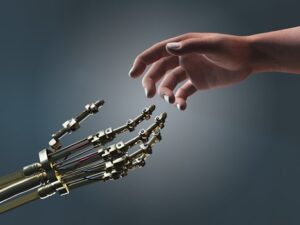By J. N. Halm

I have always held that one of the most interesting things about the rapid advancement in technology is the sheer number of new words, names, terms, and terminologies that one has to deal with regularly. It is simply fascinating. You go to bed one day and you wake up the next day to find a word you have never heard of before. Quite recently, I came across one of such terms. The word was “Cobotics”. “Collaborative Robotics” is where the term comes from. It is the new branch of robotics that is concerned with building robots to work safely alongside human workers in a shared, collaborative workspace.
It has always been known that humans and robots are always going to work together. As a matter of fact, robots were purposely created to make the work of man easier. It is therefore not surprising that collaboration between robots and humans has been going on for decades. For years, we have seen robots working side by side with humans at a factory line. We have also seen some robots helping workers with product packaging.
A more recent example of collaboration between humans and robots is that of E-commerce giant Amazon. The company has been using cobots since 2012 to help with stock picking in their warehouses. These collaborative robots carry products from worker to worker, reducing the amount of time that human workers spend walking through the warehouse. It has been found through that and similar experience that one of the advantages of having cobots on the shop floor is that they can easily be taught new tasks.
However, cobots are not only found on the factory floor. This is where it gets interesting for customer service. As stated earlier, Cobotics is about having robots and humans work together to serve customers. The truth is that many robots are already serving customers at the front line. These are known as Service Robots.
By definition, Service robots are autonomous and adaptable robots that interface, interact, communicate, and deliver service to an organisation’s customers. A typical example of such a robot is Pepper, the semi-humanoid robot that was introduced to the world in June 2014 by Japanese firm SoftBank Robotics.
Another example is NAO which was released earlier in 2008 by a French robotics firm that was eventually bought by SoftBank Robotics. In 2018, a hospital in Singapore began using a NAO robot to guide seniors with dementia in rehabilitation sessions and recovery therapy. Currently, several organisations use NAO as an educational assistant. Even before NAO robots, there was a PARO, a therapeutic robot that was designed like a baby seal. PARO was used to reduce patient stress and their caregivers, especially among elderly persons who have dementia or a loss of cognitive function.
These robots have been around for decades and they have been helping humans in more ways than one. They tend to work alone or in tandem with humans. For instance, it is not strange to see NAO and PARO robots going on ward visits in the hospitals side by side with other medical assistants.
During the COVID-19 pandemic, authorities in Singapore made use of a robot dog to ensure that people adhered to social distancing rules at one local park. The four-legged robot “dog” was used to patrol the park and was equipped to broadcast a pre-recorded message to visitors reminding them of the importance of social distancing. In 2023, travellers through Singapore’s Changi Airport had to deal with police walking side by side with two 7-foot-tall robots equipped with 360-degree vision. The intimidating atmosphere created by these cobots was on performance. People who were engaged in any form of illicit trade would have cause to be genuinely afraid of those “Robocops”.
Cobotics have arisen as a result of the concern many people have expressed about traditional robots replacing humans soon at work. Many dread a future where people would struggle with robots for work. These fears are slowly being eroded by the presence of cobots. The difference between cobots and everyday robots is that cobots are designed specially to work hand-in-hand with humans. Just imagine an assembly line in a warehouse with robots working side by side with humans to sort products. Or robots working together with humans to glue, seal, solder, and weld pieces of metals. Or even robots and humans working together to place boxes on palettes.
Soon, it will not be out of place to see cobots side by side with human tellers in banking halls serving customers. Already, robots are sitting outside banking halls being called new-generation ATMs. There is indeed a drive for us to transition into a cashless society. However, cash still refuses to go away, and this is why it should not be a surprise if cobots get into the cash-dispensing business in the not-so-distant future.
One of the concerns people have raised about cobots is the safety of their human collaborators. The number of things that can go wrong when machines work alongside humans is quite a lot. From common accidents such as humans crashing into robots, the machines stepping on humans, electrocution, and robots attacking humans, the possible wrong scenarios that can happen are quite scary.
It is for this reason that cobots had to be specially designed to work in tandem with humans. Designers have assured users that nothing untoward would happen between humans and their robot colleagues. Cobots are specifically taken through stringent safety checks to ensure that they meet the highest standards. Cobots have built-in safety sensors and other features to ensure that human workers stay safe while working near these machines. After all, they are going to work side by side with real-life humans. The last thing anybody would want is for things to get out of hand.
As can be seen from the ongoing discussion, the scenario of robots working together with front-line personnel is not something to expect in the future. Cobots are already here. Cobots are already at work and if you are not aware of this, then you are late.
It is therefore little wonder that several studies are being carried out about this very special area of robotics. One such study came out in the March 2024 edition of the Journal of the Academy of Marketing Science. The study title was “Cobotic Service Teams and Power Dynamics: Understanding and Mitigating Unintended Consequences of human-robot Collaboration in Healthcare Services”. The study sought how consumers respond to seeing humans work together with robots at the front line. This study even took the discussion a step further by testing out how customers would respond when it is robots leading the team and when it is humans leading the robot.
The findings of the study indicate that consumers were not too enthused about robots leading a team of humans in comparison to humans leading a team of robots. The findings were further confirmation that as important as robots are to the present and future of humanity, people were still a bit sceptical about robots. There is an uneasy calm regarding robots that do not seem to go away.
One cannot blame the sceptics too much with continued reports of mass job losses if robots were brought into the world of work. It makes sense to believe that robots are coming for our jobs. After all, every business that is into business for profit wants to operate as efficiently and effectively as possible. Robots give businesses advantages that cannot be underestimated.
Therefore, it makes sense to believe that a massive deployment of robots could spell doom for the jobs of many people. For as long as mainstream media keeps perpetuating this stereotype, people will still have issues with robots. However, the truth is that humans must find a way of disabusing their minds about robots and finding a way of working with these machines without any suspicions.
It is interesting to note however that the figures do not point to robots coming for our jobs. According to global management consulting firm, McKinsey & Company less than 5 percent of all occupations can be automated entirely using current technologies. It is also estimated that about 60 percent of all occupations have at least 30 percent of constituent activities that could be automated today. What this means is that robots are not coming for jobs but are rather coming to work with us. This is where cobots come in.
We find ourselves in a period when business leaders from all sectors are looking to use advanced technology to, among other things, create efficiencies and improve the quality of customer service. New technologies such as cobots are helping some businesses stay ahead of the competition.
The future of cobots is going to depend on two very important factors. Firstly, customers are getting savvier about available technologies. People are getting to know more and more about robots. As they do, they become more comfortable with these intelligent machines.
Secondly, as more and more developers get into the robot industry, deployment of these machines is slowly becoming cheaper. Currently, the average robot costs too much to make it affordable for the average business. But as demand continues to soar, the field of robotics is becoming attractive enough to lure more developers. This could only mean a reduction in the costs of acquiring these machines. It is therefore only a matter of time before massive adoption of AI-powered cobots begin to become a lot more visible in offices and workplaces around the world.
If the dreams of those behind Cobotics come true, then very soon, it would not be strange to find workplaces with robots sitting at lunch with humans. It will not be out of place in the future to hear people refer to robots as their colleagues at work or their partners on the job. Get ready for the Cobotic Invasion.










